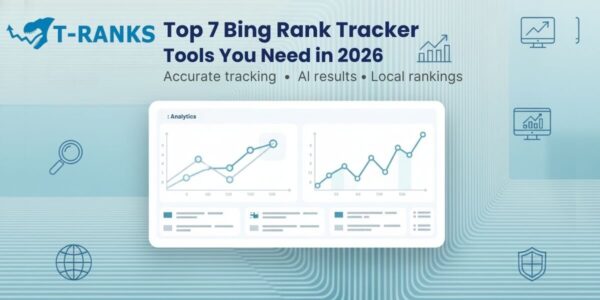Want to know how your website is performing on Bing? You’re not alone.
Bing is quietly becoming a major source of search traffic in 2026, thanks to its integration with Windows, Microsoft Edge, and workplace tools. Many people now search on Bing without even realizing it.
If you’re not tracking your rankings on Bing, you could be missing out on valuable traffic and leads. In this guide, you’ll discover 7 of the best Bing rank tracker tools to help you see where your pages stand, what’s working, and how to grow your visibility.
What Is a Bing Rank Tracker Tool?
A Bing rank tracker tool is a software tool that shows where your website ranks on Bing for specific keywords. It checks your positions automatically, tracks changes over time, and helps you understand your overall visibility. This gives you a clear picture of how well your pages perform for the search terms in Bing that matter to your business.
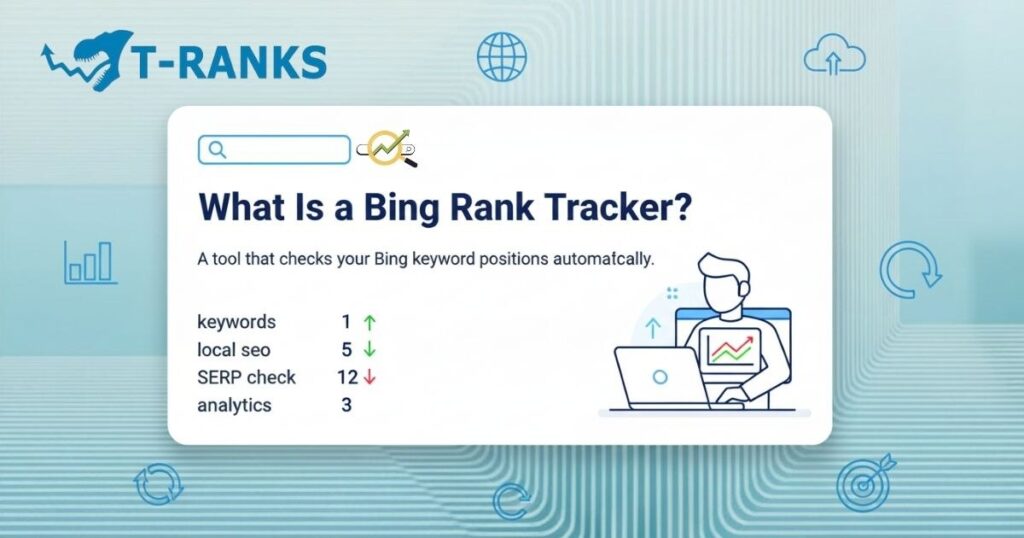
To make it even clearer, a tracker tool is basically a helper that monitors your rankings for you. Instead of searching your keywords manually on Bing every day, the tool does it for you and keeps everything in one place. It shows your wins, your drops, and the areas that need attention.
A Bing rank tracker also looks beyond basic ranking numbers. It checks whether your pages appear in quick answers, summaries, image blocks, videos, and local results. These features often show up before standard search listings, which makes them important for measuring real visibility.
Why It Matters to Use a Bing Rank Tracker Tool

Using a Bing rank tracker matters because Bing has a strong search presence, especially on desktop devices. StatCounter shows that Bing holds more than ten percent of global desktop search and more than seventeen percent in the United States. Many people search through Bing automatically because it is built into Windows and Microsoft Edge.
This audience is valuable. Bing users tend to have higher incomes, strong intent, and clear research behavior. They often look for products, services, and solutions during work hours, which leads to higher quality traffic.
A Bing rank tracker shows how well your website performs for these users. It helps you find improving keywords, spot ranking drops early, and understand how competitors move in the same search results. It also shows how Bing’s growing use of summaries and visual sections affects your visibility.
Types of Bing Rank Tracker Tools
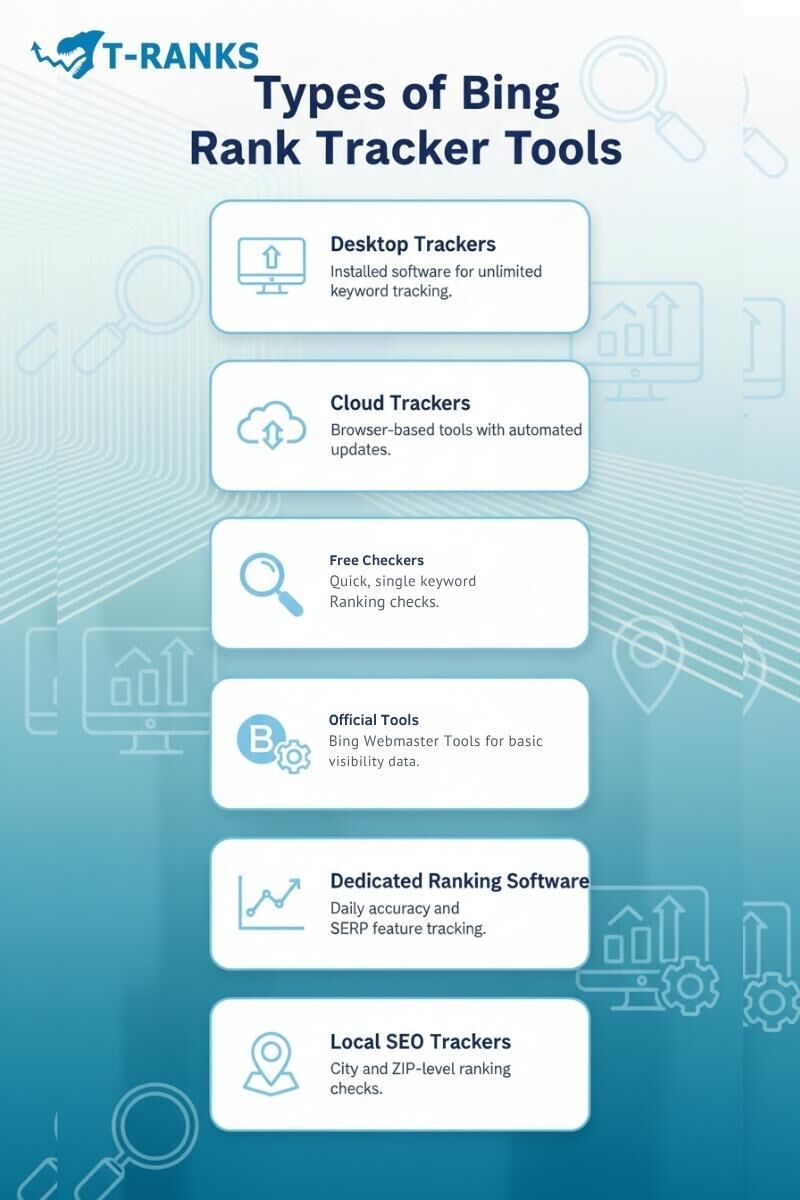
Bing rank trackers come in several types, and each one serves a different purpose.
Desktop trackers
Installed on your computer, often allowing unlimited keyword tracking. Good for long term use with predictable costs.
Cloud trackers
Used through your browser with automatic updates and shared access. Ideal for teams and agencies that want easy setup and collaboration.
Free checkers
Used for quick tests on one or two keywords. They cannot save data or support consistent tracking.
Official tools
Bing Webmaster Tools provides helpful insights like impressions, clicks, and average positions. It is reliable but not designed for full rank tracking.
Dedicated tracking software
Built for daily accuracy, location targeting, device insights, and competitor comparisons. Best for ongoing SEO work.
Local SEO trackers
Track rankings in specific cities or ZIP codes. Designed for local businesses needing precise visibility data.
Simple selection guide
• Desktop tools fit users needing unlimited tracking.
• Cloud tools fit teams wanting automation and shared dashboards.
• Free checkers fit quick, basic checks.
• Dedicated tools fit websites focused on SEO growth.
• Local tools fit businesses serving specific areas.
These categories create a smooth foundation for exploring the seven best Bing rank tracker tools for 2026.
Bing vs Google SERPs: What Makes Tracking Different

Bing’s search results in 2026 look very different from Google’s and that impacts how users interact with your content, even when you “rank.” If you only track traditional blue-link positions, you’re missing how Bing’s visual, AI-powered layout affects actual visibility.
Key Differences Between Bing and Google SERPs
- AI Answers Appear First on Bing
Bing often begins results with Copilot summaries or AI-generated answers, which can push organic links far down the page. - Image Blocks and Visual Packs
Bing places large image carousels and content tiles above standard search listings. Google shows visuals too, but typically lower or in a cleaner format. - Sidebar Layouts and Cards
Bing frequently moves results like businesses or summaries to the right-hand sidebar, reducing visibility even for high-ranking links. - Ranking Signals Differ
Bing rewards exact-match keywords, structured data, and schema markup more than Google. Google focuses more on intent and semantic meaning.
These differences mean a page that ranks first on both engines could have very different on-screen visibility depending on where and how it appears.
Real Keyword Example: “kitchen lighting ideas”
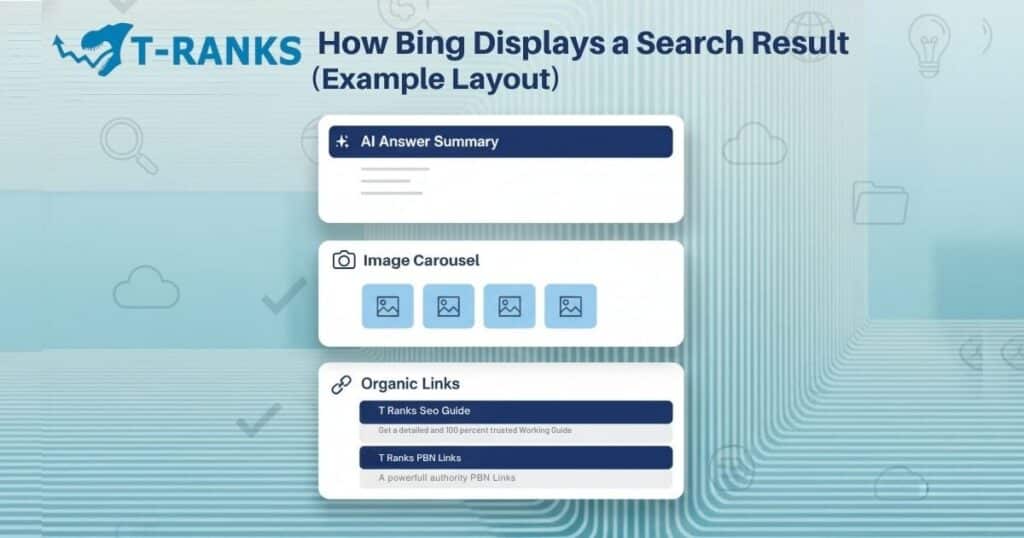
To see this in action, let’s look at the keyword “kitchen lighting ideas” and compare the actual SERP layouts.
On Bing (Screenshots 1 & 2)
- A Copilot AI answer dominates the top of the page, summarizing types of lighting with bold text and headings.
- Below it is a visual image carousel, showing tiles from blogs and decor sites.
- Organic blue links appear much lower on the page, well after these visual blocks.
Even if your page ranks #1, it’s hidden under AI and images. Traditional trackers won’t show this drop in visibility.
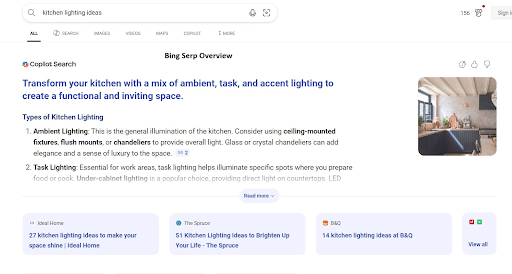
On Google (Screenshot 3)
- The top section contains structured result tiles with expandable links—clean and organized.
- No AI overview appears.
- Organic results are closer to the top, with fewer interruptions before the links.
A similar rank on Google delivers more immediate screen presence and higher click potential.
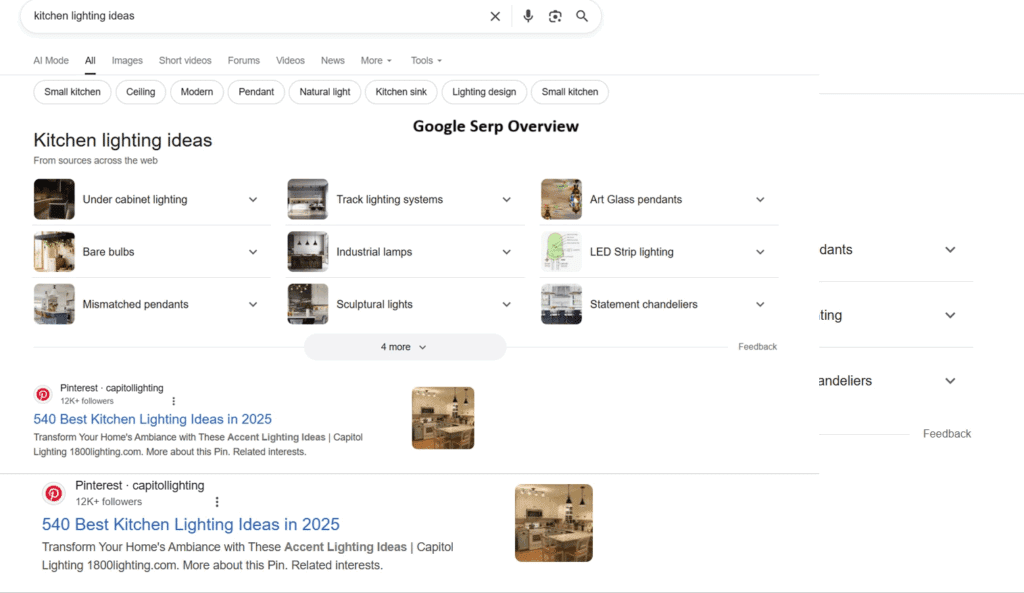
In short, Bing SERPs are layered, dynamic, and layout-first. To measure what users actually see not just what the algorithm says you need Bing-focused tracking tools that capture all these visual and AI-driven elements.
Why This Matters for Rank Tracking
A Bing rank tracker that only tells you “you’re ranking #2” doesn’t show:
- If you’re buried under AI answers or image blocks
- If you’re pushed to the sidebar
- If your content appears in a visual format, even without a top 10 position
To truly understand your Bing visibility, your tracker must detect:
- Copilot and AI answer placements
- Image and video blocks
- Card layouts and sidebar positions
- Real screen position, not just keyword rank
Key Factors to Consider When Choosing a Bing Rank Tracker

Choosing the right Bing rank tracker requires more than just checking for daily updates. You need a tool that captures how Bing displays results, supports local targeting, integrates into your reporting workflow, and grows with your project. Here’s a breakdown of what really matters.
1. Accuracy and Bing-Specific SERP Tracking
Your tracker must show real rankings as they appear on Bing—not just positions.
- Look for tools that account for visual SERP blocks, including Copilot AI answers, image packs, and sidebar placements.
- Prefer trackers that offer real-time or daily refreshes to keep up with frequent shifts.
- Tools that highlight on-screen visibility (not just numeric rank) give you clearer insights for Bing.
Why this matters:
On Bing, a top-3 rank can still appear below an image block or Copilot box. A good tracker shows what users actually see.
2. Local & Device-Specific Ranking Data
Bing SERPs change significantly by location and device. You need a tracker that supports:
- City- and ZIP-level targeting for true local SEO analysis
- Device segmentation for desktop and mobile SERPs
Example:
You might rank #2 for “pediatrician in Austin” on desktop but drop to #5 on mobile in Dallas. Without local precision, this gap stays hidden.
3. Competitor Monitoring and Keyword Capacity
Stay competitive by knowing who’s ahead and how many terms you can track.
- Choose a tool that lets you compare rankings with key competitors
- Ensure it supports enough keywords to scale your campaigns
- If you’re working at scale, look for API access to integrate ranking data into your own dashboards
4. Reporting, White-Labeling, and Automation
Efficiency is everything—especially for agencies. Look for:
- Automated report generation (weekly, monthly)
- White-label options to brand reports for clients
- One-click exports to Sheets or Looker Studio
These features reduce manual work and improve client trust.
5. Workflow Integrations and Tool Compatibility
A Bing rank tracker is only useful if it fits into your existing tools. Choose one that integrates with:
- GA4, to see how Bing rankings affect traffic
- Google Sheets, for easy keyword exports
- Looker Studio, for dashboard visualization
- Zapier, for automated alerts or Slack updates
Tip:
Some tools also support IndexNow, Bing’s native instant indexing protocol—this is a bonus.
6. Pricing Structure and Scalability
Make sure the pricing fits your needs now—and later.
- Some tools charge per keyword, while others offer unlimited tracking under flat plans
- Look for options with multi-user access and project segmentation
- If you manage several domains, ensure the tool offers permission control for team roles
Scenario Fit:
| User Type | Recommended Features |
| Freelancer | Affordable plans, ZIP/device data |
| Local Business | Strong local tracking, visual SERP preview |
| Agency | White-label, API, multi-project support |
| Enterprise | High limits, advanced integrations, automation |
The 7 Best Bing Rank Tracker Tools for 2026

Picking the best Bing rank tracker tools for 2026 can feel confusing, especially if you’re still learning how search engines work. Many tools promise daily updates and “high accuracy,” but only a handful actually give you clear insights and easy-to-understand reports. To save you time, this list highlights tools that are reliable, simple to use, and genuinely useful for websites of all sizes from small blogs to large agencies.
Before we go deeper, here’s a quick snapshot of the top options:
| Rank | Tool | Key Strength | Best For |
| 1 | SEO PowerSuite Rank Tracker | Unlimited keywords on desktop | Agencies and growing websites |
| 2 | SE Ranking | Clean, cloud tracking with reports | Small businesses and agencies |
| 3 | Nightwatch | Strong city and ZIP level tracking | Local SEO and multi-location brands |
| 4 | GeoRanker | Deep geo and map-style visibility | Local specialists and franchises |
| 5 | ChampSignal | Free and instant Bing rank checks | Beginners and freelancers |
| 6 | Rankifyer | Simple real-time Bing lookups | Bloggers and quick audits |
| 7 | AccuRanker | Fast, real-time updates and clean reports | Agencies and data-driven teams |
1. SEO PowerSuite Rank Tracker
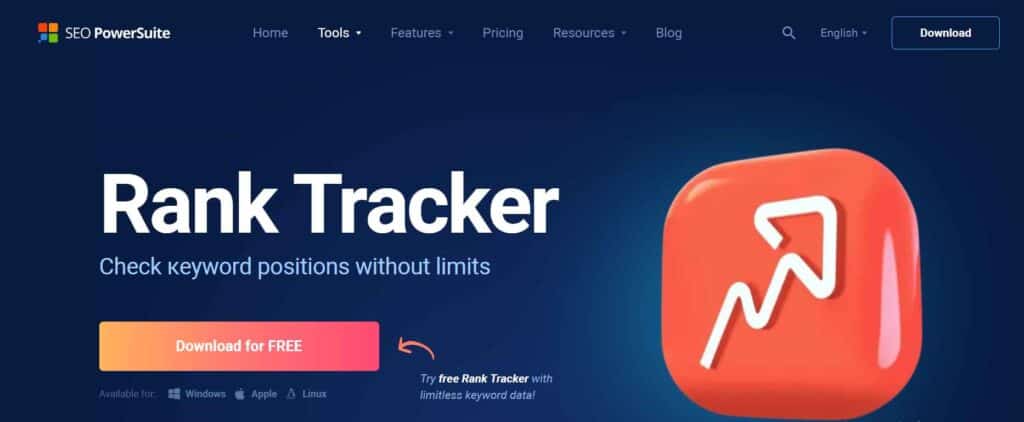
SEO PowerSuite Rank Tracker is a strong choice if you want full control over your tracking without paying extra every month. Since it runs on your computer, you can add as many keywords as you want and track Bing rankings at any scale. This makes it a great fit for beginners who plan to grow, as well as agencies managing multiple client websites.
Why SEO PowerSuite Rank Tracker is helpful for Bing
- Lets you track unlimited keywords, even huge lists
- Shows accurate Bing results for many countries and cities
- Allows competitor comparisons in one clean view
- Saves long-term history so you can track improvements clearly
- Creates professional reports ideal for clients or team updates
If you want a Bing rank tracker that scales with your goals and keeps your costs steady, this tool is a smart pick.
2. SE Ranking

SE Ranking is one of the easiest Bing rank tracking tools because everything happens online. You just log in, add your website, select Bing as your search engine, and SE Ranking takes care of the rest. The platform is very visual and beginner-friendly, making rank tracking feel simple rather than technical.
Why SE Ranking works well as a Bing rank tracker
- Tracks Bing rankings by country, city, and device
- Shows when your site appears in SERP features, like snippets
- Offers clean white-label reports for agencies and clients
- Connects directly with GA4 and Search Console
- Supports multiple team members and permissions
If you want something simple and cloud-based that “just works,” SE Ranking is an excellent place to start.
3. Nightwatch

Nightwatch is a great fit if your website relies on local customers. Instead of looking at your national ranking, you can see how you perform in individual cities and ZIP codes. This level of detail helps you understand exactly where your visibility is strong — and where it needs work.
Why Nightwatch is great for Bing local tracking
- Tracks down to ZIP code level with strong precision
- Gives daily updates with easy-to-read charts
- Lets you filter rankings by device or location
- Connects with GA4 and Search Console for deeper insights
- Ideal for multi-location brands needing local clarity
If you want to improve your visibility in specific areas, Nightwatch makes local Bing tracking much easier to understand.
4. GeoRanker
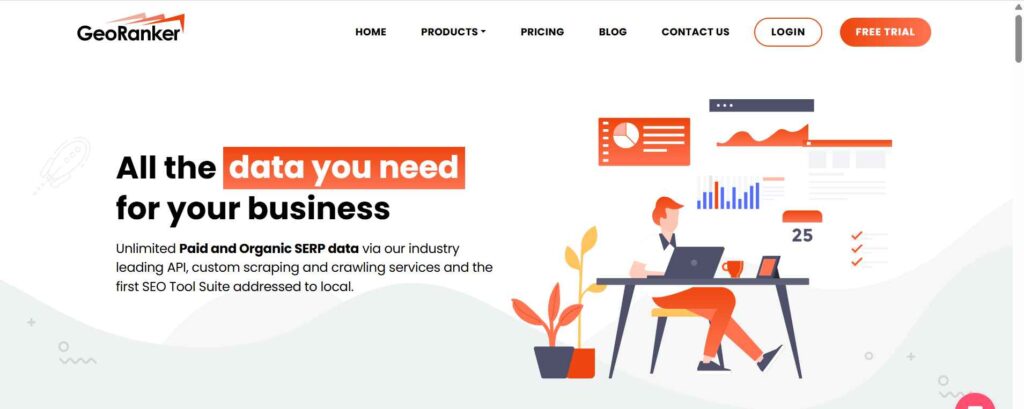
GeoRanker is designed for advanced local research, especially when your visibility varies across different neighborhoods or areas of a city. Instead of checking one location, GeoRanker can show rankings from many small points, giving you a map-like overview of your performance.
Why GeoRanker is useful for advanced Bing tracking
- Uses local IPs to mimic what real Bing users see
- Tracks rankings down to street or neighborhood level
- Supports Bing local packs and map style results
- Offers an API for custom dashboards or large datasets
- Excellent for franchises or businesses with many locations
If you need detailed and highly accurate location data, GeoRanker gives you insights that most tools don’t provide.
5. ChampSignal

ChampSignal is one of the simplest tools on this list. It’s completely free, doesn’t require an account, and gives instant Bing rankings in just seconds. It’s perfect for beginners who just want to see where they stand without learning a full platform.
Why ChampSignal is helpful
- Free, fast, and extremely simple
- No account or setup required
- Gives instant Bing ranking results
- Great for small checks or quick reviews
- Ideal for beginners or freelancers
It’s not designed for long-term tracking, but it’s very useful when you only need quick answers.
6. Rankifyer

Rankifyer works similarly to ChampSignal but provides a little more context. You enter a keyword and your site, and Rankifyer instantly shows your Bing ranking along with the other pages ranking around you. This makes it helpful for quick audits or new content checks.
Why Rankifyer is a handy Bing checker
- Gives real-time Bing SERP positions
- Shows pages ranking above and below you
- Useful for testing new content shortly after publishing
- Helpful for simple audits and spot-checks
- Beginner-friendly with no learning curve
It’s a great option when you want a fast ranking view without creating full projects.
7. AccuRanker
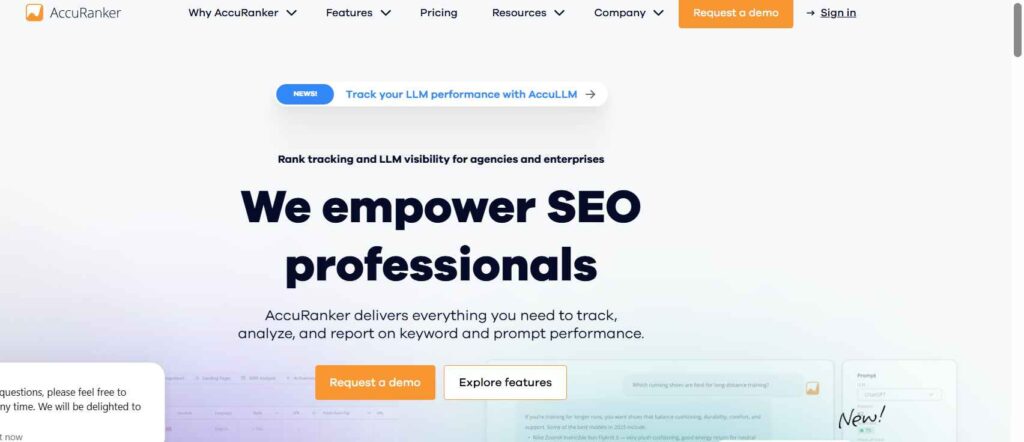
AccuRanker is the best option if you want real-time updates and top-level accuracy. It’s built for teams that need fast data, especially during new campaigns or sudden ranking changes. You can refresh rankings any time you want and see results within seconds.
Why AccuRanker is a premium Bing tracker
- Refreshes Bing rankings instantly on demand
- Tracks large keyword lists with high precision
- Offers Share of Voice for measuring overall visibility
- Connects with GA4, Looker Studio, and other data tools
- Great for organizing large keyword lists with tags and filters
If you want the fastest and most reliable Bing tracking experience, AccuRanker is hard to beat.
In Summary:
These seven Bing rank tracker tools give you everything you need to monitor and improve your visibility in 2026. Whether you want a fast free checker like ChampSignal, a beginner-friendly cloud tool like SE Ranking, or a powerful real-time platform like AccuRanker, each option brings something unique to the table. The key is choosing a tool that matches your website size, your goals, and your comfort level. Once you start tracking consistently, you’ll understand your Bing performance more clearly and make smarter decisions that strengthen your rankings over time.
How to Set Up and Use a Bing Rank Tracker Effectively
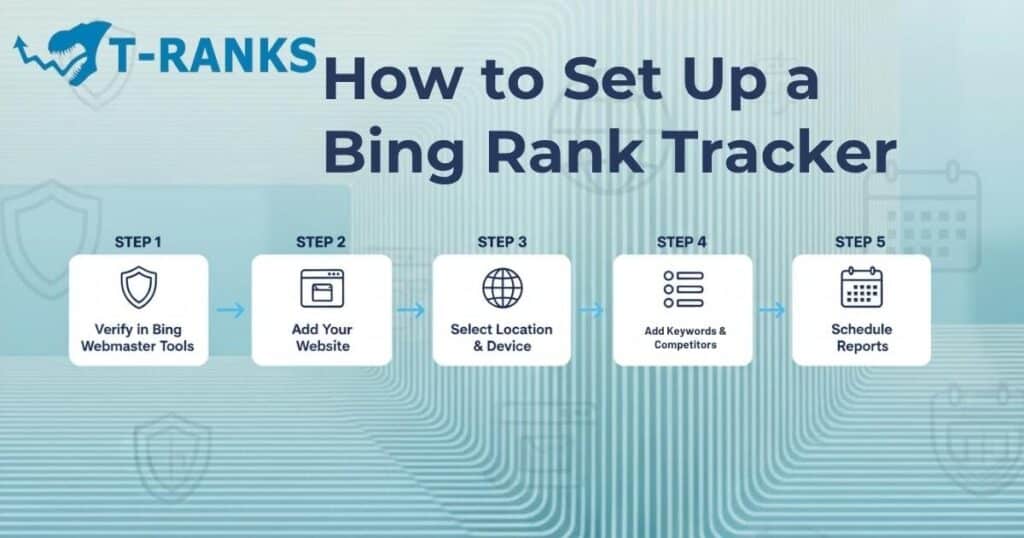
Setting up a Bing rank tracker is easier than most people think. You only need to follow a few simple steps, and once everything is in place, your tool will automatically collect ranking data for you. This section walks you through the setup process and then explains how to use your data the right way so you can improve your Bing visibility over time.
Step 1: Verify Your Website in Bing Webmaster Tools
Before using any third-party tracker, make sure your website is verified in Bing Webmaster Tools. Verification gives you direct access to Bing’s own performance data, which helps you compare what you see in your tracking tool with real numbers from Bing.
You can verify your site by adding a meta tag or uploading a small verification file. Once this is done, Bing will start showing impressions, clicks, and indexing information for your pages.
Step 2: Add Your Website Inside Your Rank Tracker
Open your chosen Bing rank tracker (such as SE Ranking, Nightwatch, or AccuRanker) and create a new project.
Enter your website URL, give it a project name, and move to the search engine settings. Make sure you select Bing most tools select Google by default, so you need to switch it manually.
If your tool supports it, also choose whether you want desktop rankings, mobile rankings, or both.
Step 3: Choose the Right Location Settings
Location is important because Bing rankings can change from one region or city to another.
Set your preferred location based on:
- Country-level tracking for general visibility
- City or ZIP-level tracking for local SEO
- Multiple regions if your business serves different areas
Choosing the right location makes your data more accurate and more useful.
Step 4: Add the Keywords You Want to Track
Next, add the keywords you want to monitor. You can:
- Type them in manually
- Upload a CSV list
- Import keywords from Google Search Console or Bing Webmaster Tools
Start with a mix of your main keywords, local keywords, and any important product or service terms.
Tip: You can always add more keywords later as your strategy grows.
Step 5: Add Your Competitors
Most rank trackers let you add competitor domains so you can compare your rankings side by side.
This helps you see:
- Who is outranking you
- Which keywords they rank for
- What content you might need to compete better
Even adding 3–5 competitors can give you a big advantage.
Step 6: Set Your Update Frequency and Reports
Now choose how often you want the tool to check your Bing rankings.
- Daily updates are best for most websites.
- Real-time or on-demand updates are helpful for active campaigns.
- Weekly updates are fine for very small projects.
Finally, schedule your reports. You can have them emailed to you or your clients automatically—daily, weekly, or monthly.
How to Use Your Bing Rank Tracker for Better Results
To use your bing rank tracker for better results, check how your rankings connect to your website traffic. If you rank well but get a few clicks, update your page titles or descriptions. Look at the SERP features your site appears in and adjust your content so it fits what Bing is showing, like local results or answer boxes. Compare your rankings with competitors to spot keywords they rank for that you don’t. Since Bing likes exact keywords and good social activity, use your data to improve your headings, content clarity, and engagement. When you publish or update content, submit it through IndexNow so Bing finds it faster. Finally, review your rankings regularly so you can keep improving and stay ahead of competitors.
Advanced Bing Tracking in 2026: More Than Just Link Positions
Bing no longer shows just a list of websites. In 2026, search results now include AI answers, Copilot panels, image rows, video carousels, and interactive cards. A traditional rank tracker that only checks blue link positions will miss these valuable placements. To get a full picture of your visibility, you need a tool that tracks everything.
Here’s what modern Bing tracking must include:
1. AI Overviews and Copilot Answers
Bing often shows an AI-generated answer before any other result. This answer may include your brand even if your website ranks at position 12 or 20. You can appear as a source inside the AI Overview without having a visible link at the top of the page. Copilot, Bing’s assistant, also provides instant answers based on trusted content. A good tracker should tell you if you’re being cited in these AI responses.
2. Visual Elements: Images and Videos
Some searches show a row of images or videos at the top, instead of websites. If your product photo or YouTube video appears here, it brings attention and clicks—even if your webpage itself does not rank on page one. A proper Bing tracker should measure these placements.
3. Local Map Packs and Cards
For location-based searches like “coffee shop near me”, Bing shows map results, not regular links. Similarly, Bing uses card-style results for quick facts, business info, and featured highlights. Tools should detect your presence in these formats too.
Live Bing Example: ‘LED Ceiling Lights Installation’
Let’s break down what Bing shows at different levels:
Top of the page
A large video carousel appears first, featuring YouTube tutorials with bold thumbnails like:
“LED Recessed Lights EASY!”,
“How to Install LED Ceiling Lights”,
“Stop Wasting $$$: Install This Light in 5 Mins.”
This section is visually dominant and clickable—ideal for DIY users. No website links are visible yet.

Lower on the page
Only after scrolling do traditional blog links show up, such as:
- “How to Put LED Lights on Ceiling” (ceilingshouse.com)
- “How to Fit an LED Ceiling Light” (interior-designy.com)

These articles are informative but buried below videos and other elements.
Best Practices for Using Bing Rank Trackers Effectively

This version avoids theory-heavy text, removes hyphens, and uses consistent formatting with short paragraphs, bolded headings, and bullet-style practical tips—just like your indexing article.
Best Practices for Using Bing Rank Trackers Effectively
Modern Bing rank trackers do more than check rankings. They help you measure visibility in AI answers, Copilot summaries, image packs, and local results. These simple best practices ensure you get full value from your tool and stay ahead of competitors.
Connect to Bing Webmaster Tools and GA4 for Full Insights
Rankings only show part of the picture. By combining your tracker with traffic and indexing data, you see what really brings clicks.
To get better insights:
- Link your tracker to Bing Webmaster Tools for impressions and CTR
- Connect Google Analytics 4 to compare rankings vs. traffic
- Identify high-ranking pages with low clicks and improve titles or descriptions
Track by City, Device, and Region
Bing results change based on user location and device type. Tracking all variations helps uncover hidden ranking gaps.
To spot missed traffic:
- Set up tracking by city or ZIP code
- Include both desktop and mobile rankings
- Use regional tracking if your business serves multiple areas
Monitor SERP Features, Not Just Rankings
Bing now shows image packs, video carousels, maps, and AI answers. These features can drive traffic even when you don’t rank in the top 10.
To capture full visibility:
- Check if your pages appear in image or video blocks
- Track placements in Copilot, AI Overviews, and answer cards
- Use schema and media content to win more visual slots
Add Competitors to Discover New Opportunities
Tracking your competition shows what keywords they rank for and which content formats work best in your niche.
To stay competitive:
- Add top competitors to your tracking list
- Monitor which features and keywords they rank for
- Analyze their new content and update your own to stay ahead
Automate Reports to Spot Trends Easily
You don’t need to check rankings daily. Automated reports help you stay focused while tracking bigger movements.
To make tracking easier:
- Schedule weekly or monthly reports
- Include ranking changes, traffic shifts, and SERP feature wins
- Watch for 2–4 week trends, not just single-day drops
Use IndexNow to Speed Up Rank Reflections
Bing supports instant indexing through IndexNow. It helps your new pages show up faster in rankings and tracking tools.
To get faster updates:
- Enable IndexNow through your SEO plugin
- Submit URLs whenever you update or add content
- Use it regularly for new blog posts or refreshed pages
Clean Up Your Keyword List Monthly
A cluttered keyword list makes your tracker hard to use. Keeping it clean ensures your reports stay focused and useful.
To stay organized:
- Remove keywords that no longer matter
- Add new keywords from Bing data or internal search logs
- Group keywords by content type or topic cluster
Turn Tracking Data Into Clear SEO Actions
The real value comes from using your data. When rankings change, respond with targeted updates or optimizations.
To take action:
- Ranking improved → Double down on what worked
- Ranking dropped → Check content quality or competitor updates
- Multiple drops → Look for algorithm updates or crawl issues
Common Mistakes to Avoid When Using Bing Rank Trackers
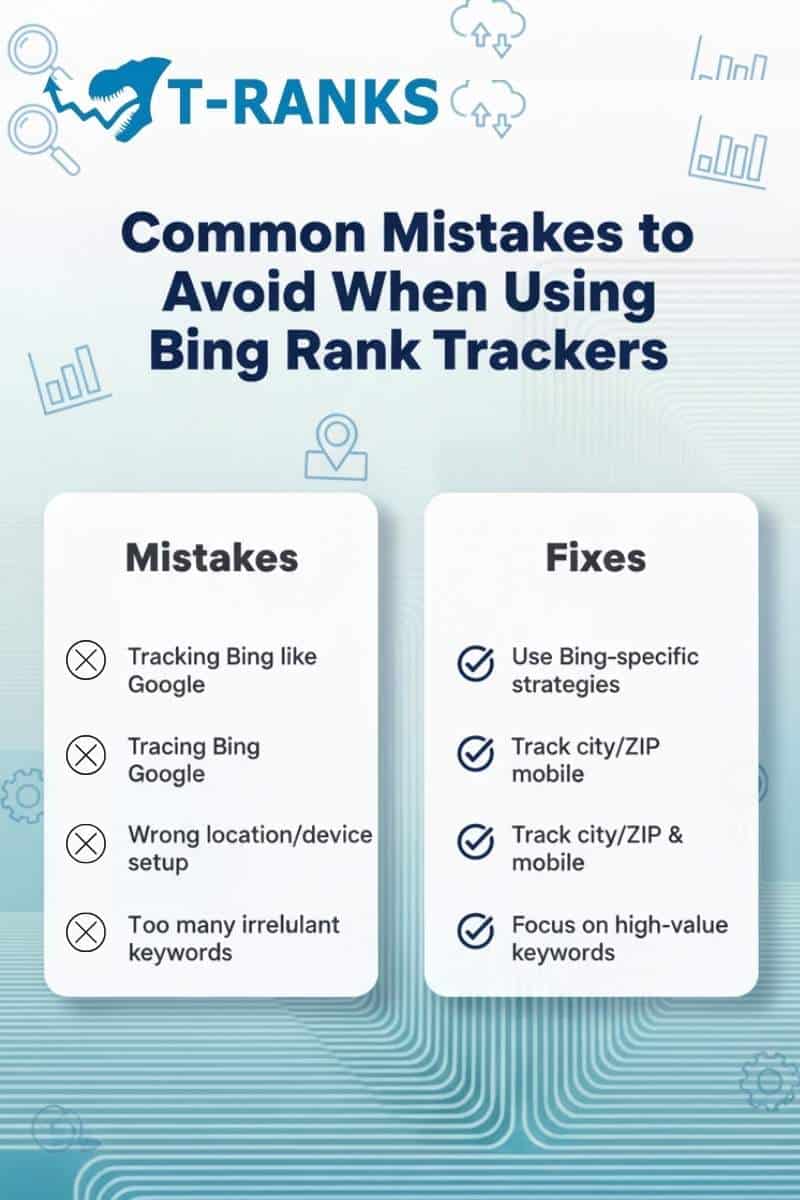
Bing rank trackers are powerful tools, but small setup errors or wrong assumptions can easily lead to inaccurate data and weak decisions. In 2026, many SEO beginners rely on Bing for growing traffic, yet misuse their tracking tools without realizing it. Avoiding these simple mistakes will help you get clearer insights, cleaner reports, and stronger improvements over time.
Here are the most common mistakes and the easy fixes:
1. Tracking Bing the Same Way You Track Google
A lot of beginners assume Bing works just like Google, but the algorithms behave differently. Bing prefers exact-match keywords and structured data, so rankings often vary.
Quick Fix:
Track Google and Bing separately. Don’t compare them directly instead adjust content for Bing’s style by adding clearer keyword usage, clean meta descriptions, and proper schema.
2. Forgetting to Set the Right Location or Device
Bing results change a lot by city, region, and device. If you only track “global” or desktop results, you’ll miss what real users actually see.
Quick Fix:
Add city or ZIP-level tracking if you serve local customers. Track desktop and mobile separately so you can spot gaps quickly.
3. Tracking Too Many Irrelevant Keywords
New users often load their tracker with 200–500 keywords “just in case.” Most of these keywords don’t matter, and they clutter your reports.
Quick Fix:
Focus on keywords with real value: your main services, local terms, and a few content topics. Remove low-value keywords every month.
4. Celebrating or Panicking Over Every Rank Change
One of the most common mistakes is reacting emotionally to small daily ups and downs. Bing rankings naturally bounce around.
Quick Fix:
Ignore 1–2 position changes. Only act when a keyword drops 5+ positions or stays down for several days. Look for the cause, not just the number.
5. Not Checking “Share of Voice”
Looking at one keyword at a time gives a very narrow view. Sometimes you rank lower for one keyword but gain more visibility overall.
Quick Fix:
Use your tool’s Visibility % or Share of Voice metrics to measure your overall presence on Bing — this gives a clearer picture of real progress.
6. Not Using Bing Webmaster Tools
Relying only on your third-party rank tracker misses important data straight from Bing.
Quick Fix:
Verify your site in Bing Webmaster Tools. Cross-check your daily rankings with Bing’s average position, impressions, and click data for a full picture.
7. Manually Checking Rankings and Assuming the Tracker Is “Wrong”
Manual searches often look different because of personalization, location, and browsing history.
Quick Fix:
Validate rankings using incognito mode with a VPN matching your tracker’s location. A difference of 1–2 positions is normal focus on trends, not one-off checks.
Avoiding these mistakes will help you get cleaner data and much more accurate insights. When your Bing rank tracker is set up correctly, you’ll know exactly where to improve — and you’ll start seeing faster, more consistent SEO results.
Conclusion
In conclusion, Bing is becoming a much more important search engine in the AI era, and tracking your rankings there is now just as essential as tracking them on Google. As Bing continues adding AI Overviews, Copilot answers, and more visual SERP features, knowing where your pages appear and how often they’re seen helps you understand your true visibility. Choosing the right Bing rank tracker simply means picking a tool that gives accurate data, saves you time with automation, and fits your budget as you grow.
If you want to stay ahead of competitors and build stronger search performance across multiple engines, start tracking your Bing rankings today and use those insights to guide your next steps.
Pro Tip: If you want to stay ahead of competitors and build stronger search performance across multiple engines, start tracking your Bing rankings today and use those insights to guide your next steps.
FAQs Of Top 7 Bing Rank Tracker Tools You Need in 2026
1. What is the best free Bing rank tracker?
The best free Bing rank tracker is ChampSignal, because it gives instant ranking results without requiring an account. It’s ideal for quick checks, although it doesn’t save history or track rankings automatically over time.
2. How accurate are Bing rank trackers?
Bing rank trackers are accurate when they use clean data centers and location-specific proxies. Paid tools like SE Ranking, Nightwatch, and AccuRanker provide highly reliable results, while free tools may vary slightly due to personalization or device differences.
3. Can Bing rank trackers measure AI Overview or Copilot visibility?
Some advanced tools can detect when your content appears in Bing’s AI Overviews or Copilot answers. Most standard trackers only measure classic blue-link results, so an AI visibility tool is needed if you want full coverage of AI-generated placements.
4. How often should I check my Bing rankings?
Checking Bing rankings daily is the most effective approach because it helps you catch shifts early. If you’re running active campaigns, choose a tool offering real-time or on-demand updates so you can react immediately.
5. Do Bing rankings differ from Google rankings?
Yes, Bing rankings differ because each search engine uses unique ranking signals. Bing rewards exact-match keywords, structured data, and social engagement, while Google focuses more on intent, topical authority, and content depth.
6. What’s the easiest Bing rank tracker for beginners?
SE Ranking is the easiest tool for beginners because it offers a clean interface and automated tracking. It handles location settings, updates, and reporting without any technical setup required.
7. Why does my Bing ranking differ when I check manually?
Manual checks often vary because Bing personalizes results based on location, device, search history, and login status. Rank trackers use clean, neutral environments, so their results are more consistent and accurate.
8. Can I track Bing rankings by city or ZIP code?
Yes, many rank trackers let you track Bing rankings at city or ZIP level. Tools like Nightwatch, GeoRanker, and SEO PowerSuite offer accurate local data, which is essential for businesses targeting specific regions.
9. Do Bing rank trackers show SERP features like image packs or local results?
Some advanced tools can detect SERP elements such as image results, local listings, or featured snippets. Not all trackers offer this detail, so choose a tool that includes SERP feature detection if visibility beyond blue links matters to you.
10. Can I use the same keyword list for both Google and Bing tracking?
Yes, you can use the same list, but performance will differ. Bing often ranks exact-match and clearly structured content higher, while Google may favor deeper, long-form content. It’s best to track both separately to understand each engine’s behavior.
